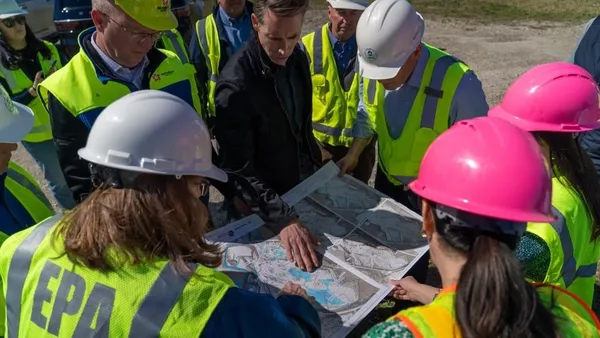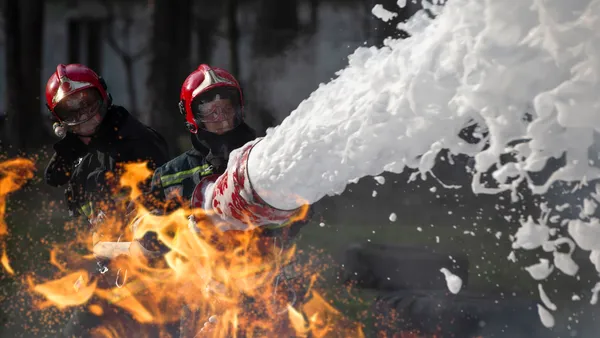Dive Brief:
- A subsidiary of Republic Services has agreed to pay a $671,000 fine and install a gas collection and control system at its Pine Avenue Landfill in Niagara Falls, New York, the U.S. EPA and Department of Justice announced Tuesday.
- The consent agreement came after the U.S. EPA alleged Allied Waste Niagara Falls Landfill, the Republic subsidiary operating the landfill, was late in submitting reports on nonmethane organic compound emissions and should have already installed the gas collection system.
- The new system to be installed by the operator is expected to destroy about 86,000 metric tons of CO2 equivalent methane emissions and 32 metric tons of nonmethane landfill gas emissions annually, per a release from the EPA.
Dive Insight:
The landfill has drawn complaints from businesses and residents in the nearby town of Niagara, who have decried its odor for years, the Niagara Gazette reported.
“Thanks to EPA’s action, the company must operate controls to dramatically slash the climate damaging pollutants that they are putting into our air every day,” EPA Region 2 Administrator Lisa Garcia said in a statement. “These pollutants also have health impacts, so cutting these pollutants not only protects the climate, it also safeguards the health of the people living near this landfill.”
In an unattributed statement, Republic Services said it was “glad to have resolved this matter with US EPA.”
“Although we respectfully disagree with EPA’s views on applicability of certain air rules to the Pine Avenue Landfill, the company has worked cooperatively with the agency to reach a resolution,” a spokesperson commented in an email.
The first cell of the landfill, which has been under Republic's control since it acquired Allied Waste Industries in 2008, opened in 1971, per documents filed with the consent agreement. Today, the Niagara Falls landfill has nine contiguous cells across 250 acres.
In the EPA's complaint against the operator, it noted that landfills with a permitted capacity equal to or greater than 2.5 million cubic meters, as the Niagara Falls landfill is, must either install a GCCS or submit regular nonmethane organic compound emissions reports. If those reports reveal the landfill exceeds emissions of 50 megagrams per year, the landfill would still be required to install a GCCS system that brought down those emissions.
The GCCS plan prepared for the landfill and accepted into the consent agreement notes that the landfill operator has installed either passive vents or, in some cases, flared vents to control the emissions coming from closed sections of the landfill. But according to the initial complaint filed by the EPA and DOJ, the Niagara Falls landfill has exceeded the 50 megagrams limit since at least December 31, 2009. As a result, Allied Waste was required to submit a plan to EPA to install a GCCS system that met federal requirements within 30 months but failed to do so.
The complaint also alleges that Allied Waste failed to implement several landfill monitoring practices, including landfill cover integrity monitoring, quarterly surface emission monitoring, monthly landfill gas pressure monitoring and monthly temperature, nitrogen and oxygen concentrations monitoring.
The landfill operator entered into corrective action negotiations with the New York Department of Environmental Conservation in 2017 to address its emissions. It’s also been in negotiations with EPA to install new gas collection wells since at least 2019, per the GCCS plan.
The consent agreement will require Allied Waste to cap vents on inactive portions of the landfill, as well as better monitor emissions and gas wells. The operator also must apply for updated permits and keep records of its compliance activities.
The EPA announced it was stepping up enforcement of landfill emissions rules last summer, which brought consternation from some in the waste industry. Methane’s role as a climate “super pollutant” and landfills’ status as the third largest stationary source of methane pollution in the United States are motivating the EPA to take action, David Uhlmann, assistant administrator for EPA’s Office of Enforcement and Compliance Assurance, noted in Tuesday’s release.
“Today’s agreement will require Allied to control its unlawful methane emissions and holds the company accountable for its violations of the Clean Air Act,” Uhlmann said in his statement.
The consent decree will go through a 30-day public comment period before receiving final approval from the U.S. District Court for the Western District of New York.















